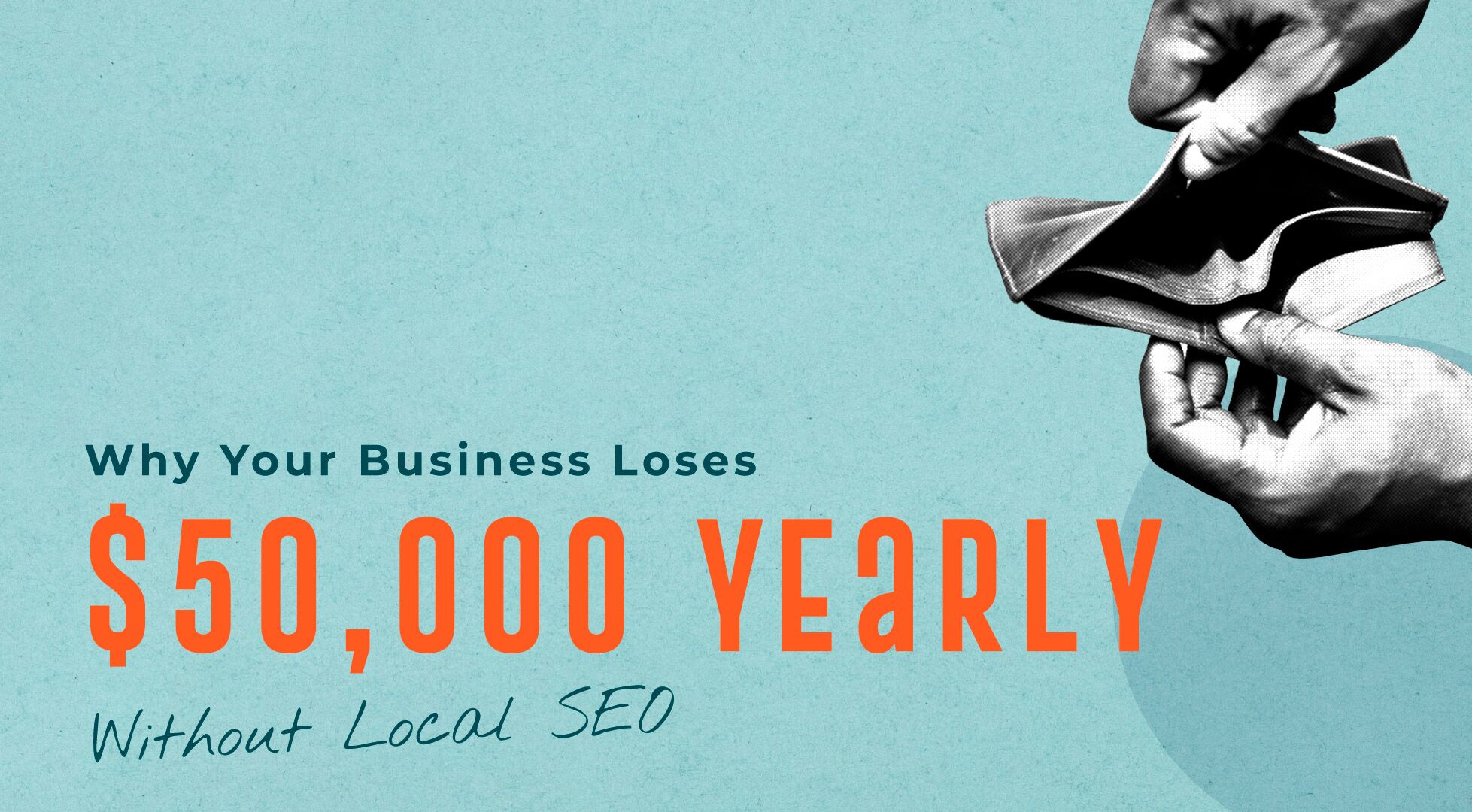Picture this: while you focus on running your business, potential customers in your neighborhood are searching for exactly what you offer. They’re ready to buy, credit cards in hand, but they can’t find you. Instead, they discover your competitors who invested in local search engine optimization. This scenario plays out thousands of times daily across America, and it’s costing small businesses serious money.
The numbers don’t lie. 80% of US consumers search online for local businesses on a weekly basis, and 32% search for them daily. When your business doesn’t appear in these searches, you’re essentially invisible to a massive pool of ready-to-buy customers. The financial impact? For many small businesses, it averages around $50,000 in lost revenue annually.
 The Hidden Cost of Local Search Invisibility
The Hidden Cost of Local Search Invisibility
Missing Out on High-Intent Customers
Local searches represent some of the highest-converting traffic you can attract. 76% of “near me” searches lead to a business visit within 24 hours, and these visitors often have their wallets ready. When people search for “plumber near me” or “pizza delivery,” they’re not browsing for fun – they need something now.
Small businesses with employees with around one to four people make $387,000 per year according to SBA data. However, businesses missing from local search results often fall significantly below this average. The gap between visible and invisible businesses can easily reach $50,000 or more annually, especially in competitive markets.
The Google Maps Factor
Google has become the default starting point for local business discovery. 87% of people use Google to help decide which business to visit. If your business isn’t optimized for local search, you’re missing out on this massive audience.
Even more concerning, 42% of local searches result in clicks on the Google Map Pack – those three businesses that appear with maps and contact information at the top of search results. Being absent from this prime real estate means losing customers to competitors who understand local SEO.
The Real Revenue Impact
Breaking Down the $50,000 Loss
Let’s examine how this figure adds up for a typical small business:
Average local search customer value: If your average customer spends $75 and local searchers convert at 20%, each local search visitor is worth $15 in potential revenue.
Monthly search volume: A local business in a mid-sized market might miss 275 relevant local searches monthly due to poor optimization.
Annual calculation: 275 searches × 12 months × $15 = $49,500 in lost revenue
This conservative estimate doesn’t account for repeat customers, referrals, or higher-value services. Many businesses lose significantly more, particularly those in professional services, healthcare, or home improvement sectors.
Industry-Specific Impacts
Different business types face varying levels of local search dependency. Restaurants, retail stores, and service-based businesses rely heavily on local discovery. Businesses with professional websites earn 50% more revenue, and those combining professional websites with local SEO see even greater benefits.
Professional services like law firms, dental offices, and consulting businesses often have higher transaction values. Missing just 10-15 local search customers monthly can easily translate to $50,000+ in annual lost revenue.
Mobile Search Dominance
Today’s consumers search differently than they did five years ago. Nine out of ten people search for a local business on their phone at least once a week. Mobile searches often happen when people need immediate solutions – a broken pipe, sudden illness, or dinner plans.
Over 75% of people searching for a local business on their phone visit the physical location within 24 hours, and 28% of those searches result in a purchase. Without local SEO, your business simply doesn’t exist in these crucial moment-of-need searches.
Beyond Direct Sales: The Multiplier Effect
Brand Awareness and Trust
Local SEO impacts extend beyond immediate sales. Businesses with a Google Business Profile are 94% more likely to be seen as trustworthy. This trust factor influences purchasing decisions and creates long-term customer relationships worth far more than single transactions.
Word-of-Mouth Marketing
Satisfied customers found through local search become brand ambassadors. They leave reviews, make referrals, and provide social proof that attracts additional customers. The $50,000 annual loss estimate only captures direct sales – the true impact includes missed opportunities for organic growth and community reputation building.
Taking Action: Immediate Steps to Stop Revenue Loss
Claim Your Google Business Profile
Start with the basics. Over half of local businesses haven’t even claimed their Google Business Profile, representing a massive missed opportunity. This free tool puts your business on Google Maps and local search results immediately.
Optimize for Mobile Searchers
Ensure your website loads quickly on mobile devices and displays correctly across all screen sizes. 63% of traffic comes from mobile, yet 40% of small businesses don’t invest in SEO. Don’t be part of that statistic.
Focus on Reviews and Reputation
90% of consumers read online reviews before visiting a business. Actively request reviews from satisfied customers and respond to all feedback professionally. This builds trust and improves local search rankings simultaneously.
For businesses serious about capturing this lost revenue, consider partnering with local SEO experts who understand search algorithms and can implement comprehensive optimization strategies. The Small Business Administration provides resources for growth strategies, while BrightLocal’s local SEO research offers detailed insights into consumer behavior patterns.
Frequently Asked Questions
Q: How quickly can local SEO start generating revenue for my business? A: Most businesses see initial improvements within 3-6 months, with significant revenue increases typically occurring within 6-12 months. On average, top-ranking pages have been around for over two and a half years, so consistency and patience are important for long-term success.
Q: Is local SEO worth it for businesses that already have steady customers? A: Absolutely. Nearly half of all Google’s 8.5 billion searches per day are local, representing massive untapped potential. Even established businesses can grow their customer base significantly through proper local optimization.
Q: What’s the most important local SEO factor for small businesses? A: Google Business Profile optimization is foundational. It’s free, immediate, and directly impacts your visibility in local search results and Google Maps. Combined with consistent business information across the web, it forms the backbone of local SEO success.
Q: How much should a small business invest in local SEO? A: The average hourly rate for local SEO services in the USA stands at $128. Most small businesses benefit from investing $500-2,000 monthly, which typically generates a strong return on investment through increased local visibility and customer acquisition.
Q: Can small businesses compete with larger companies in local search? A: Yes, local SEO actually levels the playing field. Local search algorithms prioritize relevance and proximity over business size. A well-optimized small business can outrank larger competitors in local search results, especially for location-specific queries.
Summary
The $50,000 annual revenue loss facing small businesses without local SEO isn’t speculation – it’s a measurable reality based on search behavior data and conversion patterns. With 80% of consumers conducting weekly local business searches and 76% of “near me” searches resulting in store visits within 24 hours, the opportunity cost of local search invisibility has never been higher.
The solution requires immediate action: claim and optimize your Google Business Profile, ensure mobile-friendly website performance, actively manage online reviews, and implement comprehensive local SEO strategies. For small businesses averaging $387,000 in annual revenue, investing in local SEO isn’t optional – it’s necessary for survival and growth in today’s digital marketplace. The question isn’t whether you can afford to invest in local SEO, but whether you can afford to continue losing $50,000 yearly by remaining invisible to local searchers.



